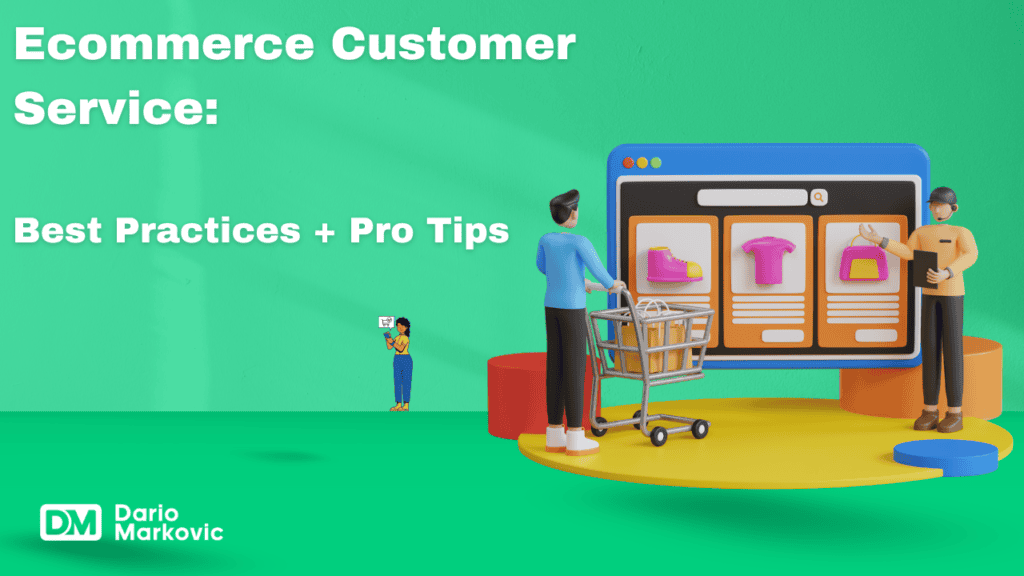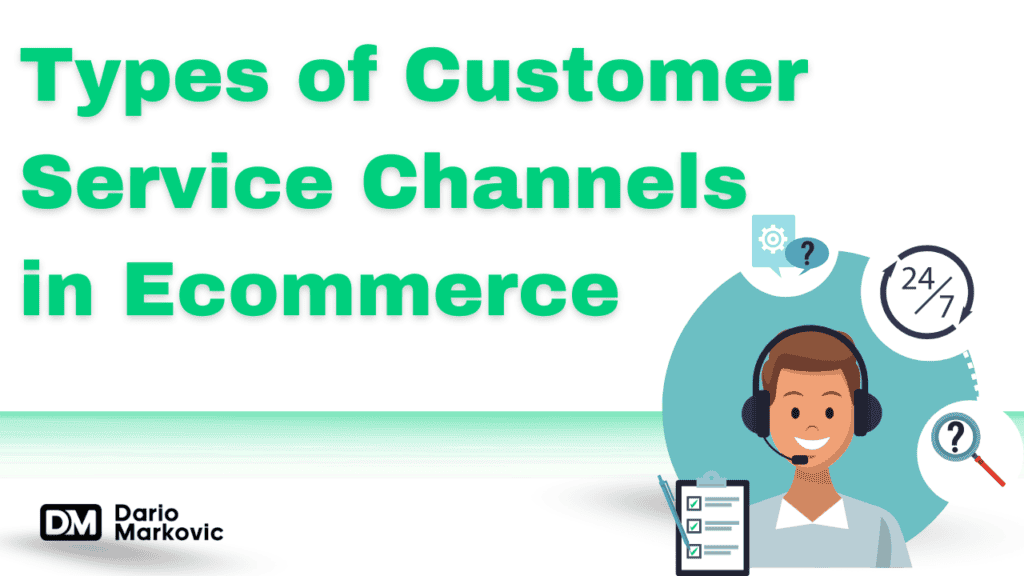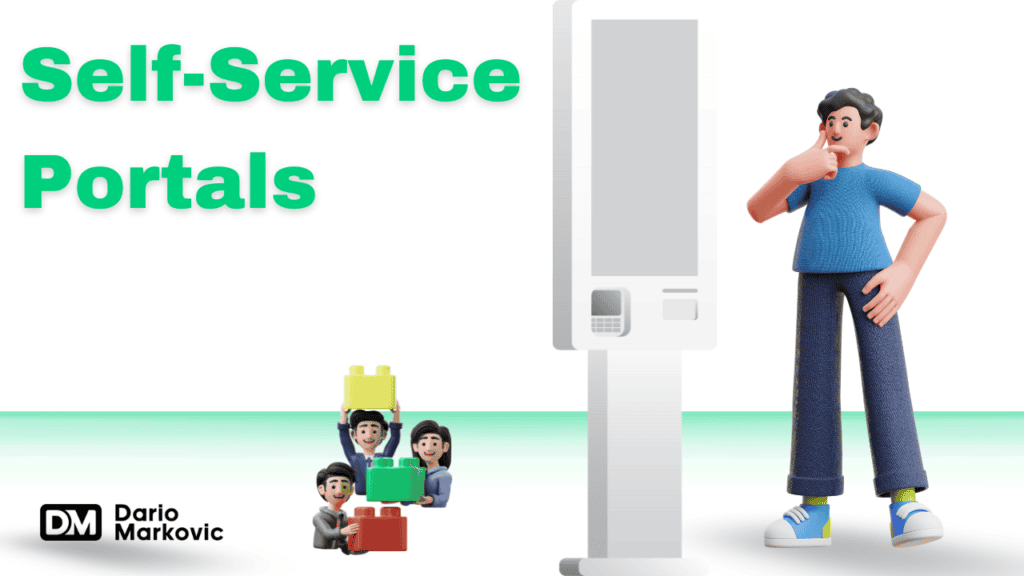For any online ecommerce business, ecommerce customer service is paramount. Our guide will help you through top strategies and best practices for quickly resolving customer questions and providing a smooth shopping experience.

We will look at different channels like phone support and chat to give you a full understanding of how to maintain high satisfaction levels among your shoppers using great ecommerce customer service.
Types of Customer Service Channels in Ecommerce
In the current digital era, many customer service channels are available to ecommerce businesses. These various platforms come with advantages and difficulties, necessitating that teams responsible for ecommerce customer service adeptly grasp and employ these alternatives.
Offering multichannel customer support—from conventional phone support to contemporary live chat and social media engagement—is crucial for fulfilling consumer expectations and improving overall satisfaction.

Let’s delve into the array of different customer service channels that bolster the provision of services within ecommerce enterprises.
1. Phone Support
Despite the proliferation of digital communication channels, phone support remains a fundamental aspect of customer service. It provides a level of direct and personal engagement that enables customers to do the following key benefits.
Key Benefits
- Voice their concerns or give feedback instantly
- Streamline the resolution process for intricate issues
- Obtain comprehensive explanations, which may be cumbersome via text-based methods

The promptness offered by your ecommerce customer support team through phone support has the potential to improve overall customer experience and facilitate quicker resolution of issues.
2. Live Chat and Chatbots
Ecommerce enterprises have found online chat and chatbots essential in delivering personalized service and instant answers.
These businesses can engage with customers via live chat software and immediate messaging pop-ups, integrating features like web analytics and help desk support.
Key Benefits
- Customers get answers to their questions immediately, which means they no longer have to wait on hold or refresh their inbox.
- Live chat and chatbots work around the clock, so your customers can get help whenever they need it, even at 3 AM.
- With the ability to track customer behavior and preferences, live chat can offer a more tailored interaction that feels personal.
- Live chat and chatbots can gather valuable insights into customer preferences and issues, helping you improve your products and services.
- These tools can easily integrate with your existing systems, like CRM and help desk software, making your operations smoother and more efficient.

Customers who value prompt responses and real-time assistance highly regard this form of communication.
3. Email Support
The customer service team for ecommerce customers continues to favor email support as a primary communication channel because it is convenient and enables the provision of in-depth, tailored replies.
This method allows for a more considered approach to inquiries, freeing the customer service representatives from the demand for on-the-spot answers, which is especially beneficial when dealing with complex matters.
Key Benefits
- Email allows for comprehensive and well-thought-out replies, which is especially useful for handling complex issues.
- Emails provide a written record of all communications, which can be referred back to if needed.
- Customers can send their inquiries at any time, and support teams can respond within a manageable timeframe.
- Handling multiple inquiries is easier with email, as support agents can manage their workload more effectively.

Maintaining individualized attention within email correspondence is crucial since customers expect responses that cater specifically to their needs rather than standardized, one-size-fits-all responses.
4. Social Media Support
Social media now serves as an influential instrument for customer support, enabling companies to:
Key Benefits
- Connect with an increasing number of consumers in the digital space
- Keep a real-time watch on their brand’s image
- Engage directly with customers
- Tend to their issues promptly
- Cultivate confidence and allegiance among them

These advantages are available through Facebook, Twitter, and Instagram. Businesses can manage remote customer communications efficiently through integration tools like Facebook Messenger.
5. Video Support
Video support is becoming a popular channel for customer assistance. It uses video calls or tutorials to deliver visual and interactive help. It allows the demonstration of product usage, troubleshooting of problems, and provision of individualized support.
Key Benefits
- Offers a more personal and humanized interaction.
- Useful for providing visual demonstrations and troubleshooting.
- Enhances customer engagement through face-to-face communication.
- Effective for resolving complex issues that are hard to explain via text.
- Builds trust and rapport with customers through direct visual interaction.

This method is especially beneficial for intricate products where visual instructions are necessary.
6. Self-Service Portals
Automated chatbots, FAQs, and knowledge bases as part of self-service portals enable customers to seek solutions to their problems independently.
Key Benefits
- Allows customers to find solutions on their own, increasing satisfaction.
- Reduces the need for extensive customer service teams.
- Offers a repository of information that customers can access anytime.

This lessens the burden on support personnel and offers immediate help. Such tools are crucial in managing routine inquiries and improving customer satisfaction.
7. SMS/Text Messaging
Text messaging, or SMS, is an efficient platform for short communications and timely updates, including delivery notifications and order confirmations.
Key Benefits
- SMS messages have a very high open rate, ensuring the message reaches the customer.
- Provides quick and direct communication for urgent issues.
- Accessible to customers who may not have internet access or prefer text messaging.
- Can be automated for reminders, confirmations, and follow-ups.

This method provides a direct and instantaneous approach to connecting with customers, guaranteeing the transmission of essential information without delay.
Understanding Ecommerce Customer Service
Delivering exceptional customer service is critical for any online store. It encompasses various tactics, tools, and personal interactions that assist customers in purchasing. E-commerce businesses must navigate the distinct challenges of an online setting where consumers anticipate immediate, efficient, and customized help.
Outstanding ecommerce customer service does more than just address problems. It cultivates a favorable brand image that encourages ongoing patronage and word-of-mouth referrals. A well-crafted customer service strategy can distinguish an online business from its rivals by enhancing consumer contentment and loyalty, propelling profits.
Key Differences Between Ecommerce and Retail Customer Service
Ecommerce customer service, being inherently digital, comes with challenges not usually found in brick-and-mortar retail. The influx of inquiries tends to be much larger, and customers’ expectations are significantly higher because online shopping offers immediate gratification and convenience. Customers expect prompt support, fluid communication channels, and swift problem-solving.
Enhanced technologies, like 4G and 5G, raise these customer expectations even higher. It becomes essential for ecommerce businesses to leverage these technological tools to meet and exceed customer standards. Ecommerce companies that grasp these distinctions can adapt their strategies for providing customer service in a way that aligns with the specific needs of their online consumer base.
Building and Optimizing Your Ecommerce Customer Service Team
The initial task in assembling an efficient ecommerce customer service team involves assessing the scale and requirements of your company. Establishing a system that upholds excellent customer service is crucial, and it entails incorporating tools such as shared inboxes and collision detection features to maintain organization and proficiency within the team.
To provide top-tier support, it’s vital to equip your team with appropriate tools and instructions for handling various customer interactions. Concentrating on effective recruitment, education, and oversight of your customer service representatives will guarantee they are ready to satisfy customer expectations and deliver outstanding assistance.
Hiring the Right Customer Service Representatives
Securing the ideal customer service representatives is crucial for the success of an ecommerce business. It’s important to consider applicants with robust written communication skills since they’ll primarily interact with customers through email and live chat. Those with an optimistic demeanor are more adept at managing agitated customers by transforming adverse situations into favorable outcomes.
By carefully choosing these candidates, you will cultivate a customer service team that thrives on delivering superb customer service. This commitment improves overall customer satisfaction and fosters enduring loyalty among your clientele.
Training and Upskilling Customer Service Agents
Ensuring that your customer service team remains top-notch requires constant training and skill enhancement. Regularly holding sessions to bolster product knowledge and instill customer service best practices empowers them to solve problems effectively during initial interactions with customers. It’s also beneficial for agents to record procedures and feedback, which can refine subsequent training and boost the efficiency of operations.
Investment in your customer service agents’ growth is crucial. It equips them with the necessary tools to adapt to changing customer demands, guaranteeing superior assistance.
Remote Customer Service Teams
Overseeing remote customer service teams comes with its own set of hurdles, yet these can be overcome by implementing effective strategies. To ensure uninterrupted operations, it’s crucial to equip these teams with dependable technology and tools for communication. Holding consistent virtual meetings is key for sustaining unity within the team and monitoring advancements, guaranteeing that all members are in sync with the company’s objectives.
Adopting top methods for managing a remote workforce allows you to establish a united and proficient customer service team capable of providing exceptional assistance globally.
Enhancing Customer Experience Through Proactive Customer Service
Proactive customer service has the potential to greatly enhance the customer experience by foreseeing and resolving problems before they arise. Providing self-service resources such as knowledge bases can lead to at least a 20% decrease in support requests, allowing customers to resolve issues independently.
Likewise, businesses must act on customer feedback. Doing so allows them to address reported concerns and demonstrate problem resolution to their customers.
Leveraging Customer Feedback
Utilizing customer feedback is an effective method for enhancing customer service and fostering brand loyalty. When brands actively seek out and respond to feedback, 77% of consumers perceive them more favorably. Customer reviews serve as critical indicators throughout the customer journey, revealing potential enhancements and areas where businesses excel.
Recognizing all types of feedback ensures that customers feel acknowledged and valued, which is vital in maintaining loyal customers. By employing insights from these reviews strategically, companies can refine their approach to customer service, ultimately improving the overall experience for their clients.
Personalizing Customer Interactions
Providing tailored and significant customer service is crucial for fostering an individualized experience. An overwhelming majority, 71%, of customers express annoyance with impersonal experiences, while one-third terminate their relationship with businesses over insufficient personalization.
Personalizing customer interactions can greatly improve the quality of the customer experience and reinforce brand loyalty. Businesses that leverage customer data to customize their responses and suggestions are able to deliver a more compelling and fulfilling experience that resonates with each customer’s unique needs and choices.
Improving Response Times and First Contact Resolution
In the dynamic realm of ecommerce, delivering swift and convenient service is crucial. Consumers expect rapid responses and immediate solutions through various communication channels. The ability to respond quickly can be critical for a business’s success as it helps retain customers who might otherwise switch to competitors due to slow response times.
Improving first contact resolution rates is essential to ensuring customer inquiries are resolved during the first engagement with them. By adopting measures such as automation and defined Service Level Agreements (SLAs), companies can elevate their customer service experience and foster stronger customer loyalty.
Implementing Automation
Automation tools and AI-powered chatbots significantly improve efficiency and streamline customer service operations. Live chat solutions that deliver instant answers effectively handle many queries. Automated responses establish transparent expectations and elevate customer satisfaction by immediately recognizing customer inquiries.
By dealing with numerous repetitive questions, AI-driven chatbots enable human agents to concentrate on more complex matters. Automation instruments aid in sorting and ranking customer inquiries according to their importance and subject matter, guaranteeing promptness and contextual appropriateness in responses.
Setting Clear Service Level Agreements (SLAs)
Establishing realistic and achievable Service Level Agreements (SLAs) is crucial for effectively managing customer expectations, leading to enhanced satisfaction. These SLAs must accurately represent a business’s ability to fulfill them. It is important to consistently review and modify these agreements to stay pertinent and useful.
When businesses adhere strictly to SLAs, they can focus on customer service by establishing clear targets and evaluating their performance against those predefined objectives. Such a methodical strategy contributes significantly to elevating service excellence and boosting overall customer satisfaction.
Best Practices for Multichannel Customer Support
Ensuring a uniform and uninterrupted customer support experience across various channels is crucial to fulfilling contemporary consumer expectations. A comprehensive omnichannel support approach guarantees that customers receive the same quality of service, no matter their chosen mode of communication.
Addressing negative feedback and fostering consumer trust requires exceptional customer service throughout all touchpoints. Integrating customer information and maintaining consistent communication is key to developing an effective and unified multichannel customer support system.
Integrating Customer Data Across Channels
Unifying customer support across different channels is essential for delivering a consistent experience. By integrating customer data seamlessly, ecommerce platforms can harness information that cultivates loyalty, streamline order management, and furnish self-service capabilities.
Incorporating social media into a comprehensive platform for customer assistance yields multiple advantages.
Heightens exposure
Reduces time expenditure
Simplifies the support workflow
Bolsters customer contentment
Consistent Messaging
Maintaining trust and reliability with customers is crucial, and this can be achieved through consistent messaging across all communication channels. Employing a shared inbox platform allows for uniformity in responses, strengthening the brand’s reputation.
Delivering consistent messages enables companies to craft an integrated customer experience that upholds their brand values and aligns with customer expectations. Such strategies are key to fostering enduring customer loyalty and satisfaction.
Common Customer Service Issues and Solutions in Ecommerce
To preserve customer satisfaction and trust, ecommerce businesses must promptly and transparently tackle frequent customer service obstacles such as difficulties with shipping, payment problems, and challenges accessing accounts.
Handling High Volume During Peak Times
Strategic planning and scalable solutions are key to handling heightened customer service demand during busy periods. By adjusting staffing to match the high-demand times, swift responses can be maintained. Employing live chat tools that deliver instant answers is an effective way of managing increased customer inquiries.
Leveraging outsourcing for customer support offers a flexible approach with on-demand resources capable of addressing seasonal spikes without necessitating enduring obligations. Businesses benefit from scalable outsourcing models by being able to modify their capacity for customer service based on varying levels of demand.
Addressing Negative Reviews
Addressing negative feedback promptly demonstrates to customers that their opinions are respected and carefully considered. Quick, individualized reactions can markedly boost customer satisfaction and their view of the brand.
When a business presents a remedy or offers compensation in response to unfavorable critiques, it can mitigate the reviewer’s dissatisfaction. Engaging with consumers who have raised issues allows companies to convert dissatisfied customers into loyal ones while improving their public image.
The Role of Technology in Ecommerce Customer Service
Technology plays a pivotal role in contemporary ecommerce customer service, enabling companies to provide support that is both effective and efficient. With platforms such as eDesk, businesses can centralize their communication on a single dashboard, automate routine tasks, and ensure an outstanding customer experience.
By incorporating self-service options and live chat features into the online shopping journey, customers’ obstacles are minimized, which enhances their chances of completing their purchases. By harnessing technology’s capabilities, enterprises can optimize their processes and deliver great customer service.
Ecommerce Customer Service Software
Ecommerce customer service software can reduce the volume of support inquiries by at least 20% by leveraging self-service features such as knowledge bases. Centralized ticket management is enabled through help desk portals, which consolidate all tickets into one dashboard and eliminate the need for agents to toggle between different windows, thus enhancing productivity.
Live chat platforms like Tidio and LiveChat seamlessly integrate with ecommerce sites. They employ chatbot technology that expedites reply times and significantly bolsters ecommerce customer satisfaction overall.
AI and Machine Learning
AI and machine learning technologies have transformed ecommerce customer service by offering immediate responses and greatly improving reaction times. These advancements support self-service customer support through chatbots that promptly resolve routine inquiries, thus liberating human representatives to tackle more complex problems.
These AI-powered instruments also refine the process of analyzing and inputting data, enabling customer service personnel to dedicate their efforts towards direct engagement with consumers, thereby providing a customized experience.
Measuring Success: Key Metrics for Ecommerce Customer Service
It is crucial for ongoing enhancement to gauge the success of your customer service endeavors within an ecommerce context. Metrics such as the Customer Satisfaction Score (CSAT), Net Promoter Score (NPS), and First Contact Resolution Rate are pivotal in gaining insights into how satisfied customers are, their loyalty levels, and the effectiveness of your service.
Monitoring these key indicators allows companies to pinpoint areas that need improvement, establish goals for performance, and refine their comprehensive strategy for customer service. This tracking helps ensure a business remains aligned with its objectives on enhancing ecommerce customer experiences.
Customer Satisfaction Score (CSAT)
Customer satisfaction, or CSAT, is gauged by asking consumers to assess their happiness with support received using a scale ranging from 1 to 5 in surveys. A robust customer satisfaction level is reflected through high scores on these surveys and indicates the quality of service.
To improve CSAT ratings, companies must deliver excellent customer service by quickly resolving problems and offering customized interactions. Concentrating on achieving high levels of customer satisfaction not only bolsters a business’s image but also fosters enduring customer loyalty.
Net Promoter Score (NPS)
NPS gauges customer loyalty by sorting survey participants into promoters, passives, and detractors according to their propensity to recommend the company. An NPS score above 50 is deemed an exceptional sign of strong customer loyalty and favorable consumer experiences.
For businesses aiming to elevate their NPS scores, it is advised that they:
Provide unwaveringly superior customer service
Tackle problems identified by those who are considered detractors
By instituting these practices, companies can amplify their NPS, which will in turn help cultivate a steadfast clientele.
First Contact Resolution Rate
The First Contact Resolution Rate indicates the proportion of customer support queries solved during the initial engagement with a service representative. Elevated levels in this metric imply effective problem-solving capabilities, contributing to heightened customer satisfaction and diminished operations costs.
To improve first contact resolution, thorough education must be provided for customer service agents, automated systems for process optimization are implemented, and explicit expectations regarding services are established. Concentrating on swift issue resolutions can lead companies to bolster both their efficacy in providing customer care as well as overall client satisfaction.
Dario’s Conclusion
In conclusion, providing exceptional ecommerce customer service involves leveraging multiple channels, implementing proactive strategies, and utilizing technology to streamline operations. By understanding the unique challenges of ecommerce, building and optimizing a skilled customer service team, and measuring success through key metrics, businesses can create a satisfying and loyal customer base.
By following the best practices outlined in this guide, ecommerce companies can enhance good customer service experience, ensuring happy customers who return and recommend the brand to others. Embrace these strategies, and let your customer service be the cornerstone of your ecommerce success.
Frequently Asked Questions
Phone support in ecommerce customer service offers direct interaction with customers, meets the preference of those who favor phone calls, and integrates easily with CRM systems for efficient issue resolution.
This can lead to higher customer satisfaction and loyalty.
By utilizing automation tools for repetitive inquiries, ecommerce customers can receive immediate responses, while human agents are available to tackle more complex problems. This boosts efficiency and amplifies customer satisfaction by ensuring quick resolution of issues.
Enhancing satisfaction, building loyalty, and effectively addressing individual needs through personalized customer interaction is essential in ecommerce. It minimizes the frustration that comes from impersonal interactions.
To manage an influx of customer inquiries during busy periods, companies can adjust their workforce according to the need, employ live chat solutions to provide immediate responses and outsource their customer support for a more adaptable approach.
Such strategies will guarantee prompt and effective resolution of customers’ concerns or questions.
In ecommerce customer service, the pivotal achievement indicators include Customer Satisfaction Score (CSAT), Net Promoter Score (NPS), and First Contact Resolution Rate. These metrics provide critical understanding regarding customer satisfaction, loyalty, and service proficiency.



